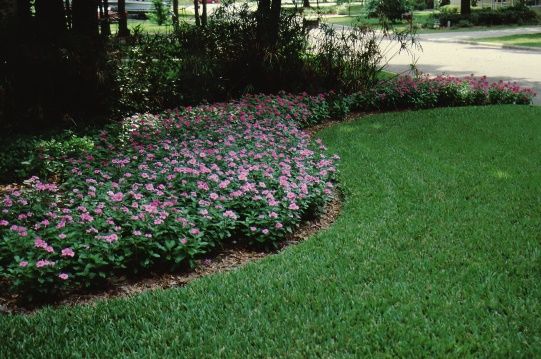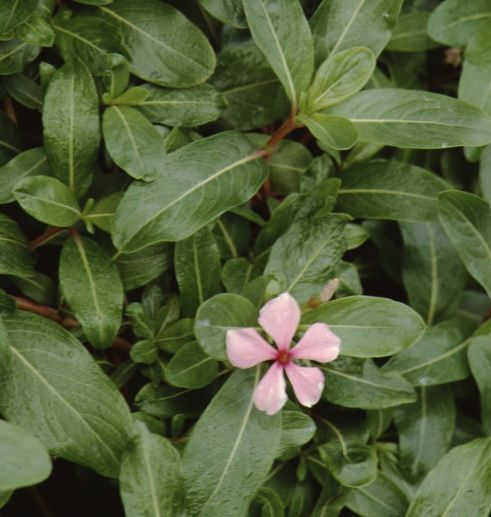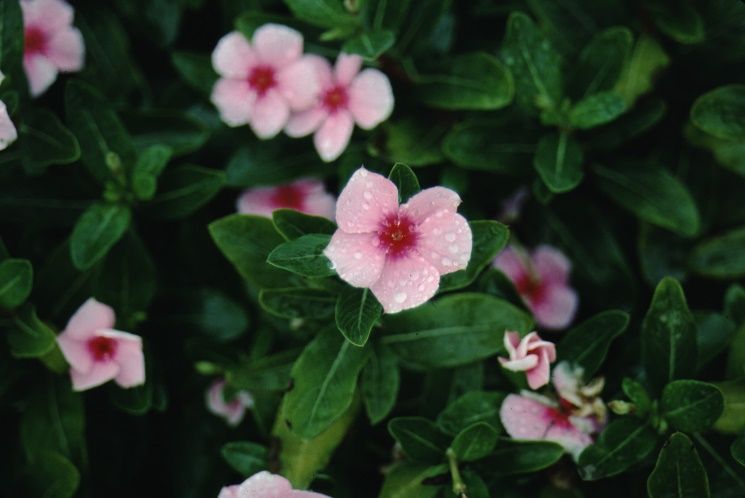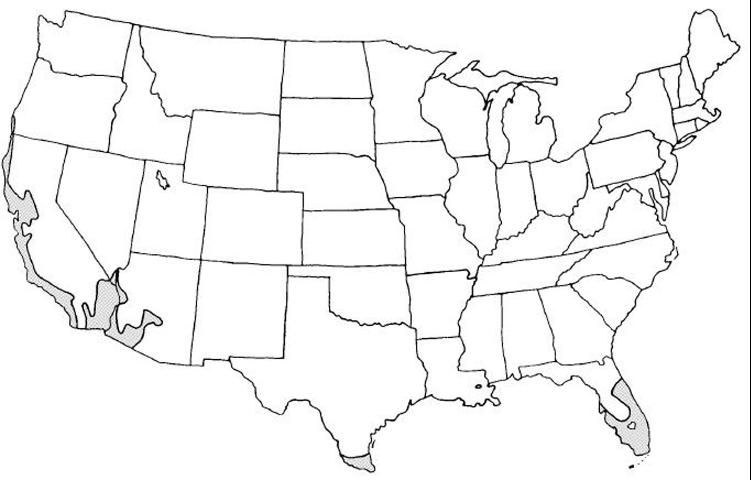Introduction
Also known as Vinca rosea, Vinca multiflora, periwinkle grows 7 to 24 inches high and wide, forming a mound of colorful flowers in white, pink, or rosy-purple on brittle stems. Cultivars are available with carpet-like or upright habits. Flowering is prolific throughout the warm months, although plants may establish poorly in very hot weather. The plant tolerates heat and flowers in the hottest weather, probably better than most other flowering ground covers. Spaced 12 to 20 inches apart, plants will form a solid mass of mounded foliage and flowers 6 to 8 weeks after sowing seed, provided they are fertilized, watered lightly (or not at all), and planted in full sun.

Credit: Edward F. Gilman, UF/IFAS

Credit: Edward F. Gilman, UF/IFAS

Credit: Edward F. Gilman, UF/IFAS
General Information
Scientific name: Catharanthus roseus
Pronunciation: kath-uh-RANTH-us ROE-zee-us
Common name(s): periwinkle, vinca, Madagascar periwinkle
Family: Apocynaceae
Plant type: annual; perennial; herbaceous; ground cover
USDA hardiness zones: 9B through 11 (Figure 4)
Planting month for zone 7: Jun
Planting month for zone 8: May; Jun
Planting month for zone 9: Apr; May; Jun; Sep; Oct
Planting month for zone 10 and 11: Feb; Mar; Apr; May; Sep; Oct; Nov; Dec
Origin: native to Africa
Invasive potential: Caution—may be recommended by UF/IFAS faculty but should be managed to prevent its escape (reassess in 2 years)
Uses: edging; ground cover; mass planting; naturalizing; hanging basket; cascading down a wall; border
Availability: generally available in many areas within its hardiness range

Credit: undefined
Description
Height: 1 to 2 feet
Spread: 1 to 2 feet
Plant habit: round
Plant density: moderate
Growth rate: moderate
Texture: medium
Foliage
Leaf arrangement: opposite/subopposite
Leaf type: simple
Leaf margin: entire
Leaf shape: elliptic (oval)
Leaf venation: pinnate
Leaf type and persistence: deciduous
Leaf blade length: 2 to 4 inches
Leaf color: green
Fall color: not applicable
Fall characteristic: not applicable
Flower
Flower color: pink; purple; lavender
Flower characteristic: year-round flowering
Fruit
Fruit shape: pod or pod-like
Fruit length: ½ to 1 inch
Fruit cover: dry or hard
Texture: medium
Fruit color: green
Fruit characteristic: inconspicuous and not showy
Trunk and Branches
Trunk/bark/branches: not applicable
Current year stem/twig color: green
Current year stem/twig thickness: medium
Culture
Light requirement: plant grows in part shade/part sun
Soil tolerances: clay; sand; acidic; slightly alkaline; loam
Drought tolerance: high
Soil salt tolerances: unknown
Plant spacing: 12 to 18 inches
Other
Roots: not applicable
Winter interest: plant has winter interest due to unusual form, nice persistent fruits, showy winter trunk, or winter flowers
Outstanding plant: not particularly outstanding
Pest resistance: very sensitive to one or more pests or diseases which can affect plant health or aesthetics
Use and Management
Periwinkle will cascade over a wall or container and makes a nice hanging basket. Derivatives from periwinkle are used in a variety of medicines and treatments for human ailments including leukemia and Hodgkin’s disease. Plants seed themselves into the landscape.
The plant requires full sun and has a long growing period. Periwinkle likes to be kept on the dry side and the roots will rot if irrigated too frequently. It is best not to irrigate periwinkle more than two or three times after it is planted. Once summer rains begin, plants often succumb to root rot diseases from too much water. A bed of periwinkle looks great until this time, but it should usually be considered a short lived annual. A three-month period of color without disease is considered very good. Once plants are removed, plant with another annual to finish the season. Some horticulturists have success growing periwinkle on a raised bed comprised of sand or other very well-drained soil.
Propagation is by seed or cuttings. Softwood cuttings can be taken and rooted during summer. The seed germinates in one week at a temperature of 70°F to 75°F. Keep the flat of seeds in the dark until the seed germinates and do not overwater. Planting may be done at any time during the year in USDA hardiness zones 10 and 11.
There are a variety of cultivars available for flower color and plant size. The 'Carpet' and 'Little' Series grow to no more than 12 inches tall. They too are sensitive to root disease.
Pests and Diseases
No pests are of major concern.
Root rots regularly cause decay of roots and lower stems.
Fusarium wilt can cause plant death.
Blight causes brown or black spots which extend inward from the leaf edge and eventually cover the whole leaf. Space plants farther apart in subsequent plantings. Remove infected plants.
Canker and dieback cause the shoot tip to become dark brown, wilt, and die back to the soil surface. The disease is most common during rainy weather. Infected plants should be discarded.
Several fungi cause leaf spots on periwinkle but they are usually harmless.